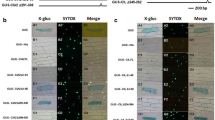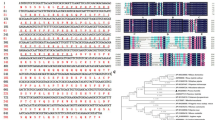Abstract
Biomacromolecules import into the nucleus is a complex progress which requires the participation of several cytosolic factors, and nuclear transport factor 2 (NTF2) is one of essential components in nuclear trafficking. Its main role is to transport RanGDP from cytoplasm to nucleus by interacting with FxFG nucleoporin repeats. In the study a putative new gene, designated as CcNTF2, was obtained from the moss (Conocephalum conicum) cDNA library we have constructed. The full-length cDNA sequence is 913 bp in size contains a 372 bp open reading frame (ORF) flanked by a 195 bp 5′-untranslated sequence and a long 346 bp 3′-non-coding region, encoding 123 amino acids of 13,575.3 Da. Part of the genomic sequence was also cloned and sequenced, which is 1,602 bp long and possesses two exons and one intron. Alignment analysis showed that the CcNTF2 protein is high conserved among plant NTF2 and shares 81% similarity with the ones from Arabidopsis thaliana and Brassica rapa. The expression of wild-type CcNTF2 was detected by immunoblotting of extraction of C. conicum and it indicated the putative protein is integral. Through functional expression of CcNTF2-green fluorescent protein (GFP) in tobacco, it was demonstrated that CcNTF2 can accumulate at the nuclear rim. Site-directed mutagenesis analysis confirmed CcNTF2 P71K has influence on the protein import into nucleus. In addition, overexpression of CcNTF2 P71K was observed to be deleterious for the plant cell. It is the first illumination of NTF2 in moss, and our study established the primary foundation for further research on moss NTF2.






Similar content being viewed by others
References
Quimby BB, Leung SW, Bayliss R, Harreman MT, Thirumala G, Stewart M, Corbett AH (2001) Functional analysis of the hydrophobic patch on nuclear transport factor 2 involved in interactions with the nuclear pore in vivo. J Biol Chem 276:38820–38829
Rout MP, Aitchison JD, Suprapto A, Hjertaas K, Zhao Y, Chait BT (2000) The yeast nuclear pore complex: composition, architecture, and transport mechanism. J Cell Biol 148:635–652
Rout MP, Wente SR (1994) Pores for thought: nuclear pore complex proteins. Trends Cell Biol 4:357–365
Macara IG (2001) Transport into and out of the nucleus. Microbiol Mol Biol Rev 65:570–594
Moore MS (1998) Ran and nuclear transport. J Biol Chem 273:22857–22860
Avis JM, Clarke PR (1996) Ran, a GTPase involved in nuclear processes: its regulators and effectors. J Cell Sci 109:2423–2427
Matunis MJ, Coutavas E, Blobel G (1996) A novel ubiquitin-like modification modulates the partitioning of the Ran-GTPase-activating protein RanGAP1 between the cytosol and the nuclear pore complex. J Cell Biol 135:1457–1470
Gorlich D, Mattaj IW (1996) Nucleocytoplasmic transport. Science 271:1513–1518
Kubitscheck U, Grünwald D, Hoekstra A, Rohleder D, Kues T, Siebrasse JP, Peters R (2005) Nuclear transport of single molecules:dwell times at the nuclear pore complex. J Cell Biol 168(2):233–243
Moore MS, Blobel G (1994) Purification of a Ran-interacting protein that is required for protein import into the nucleus. Proc Natl Acad Sci 91:10212–10216
Clarkson WD, Kent HM, Stewart M (1996) Separate binding sites on nuclear transport factor 2 (NTF2) for GDP-Ran and the phenylalanine-rich repeat regions of nucleoporins p62 and Nsp1p. J Mol Biol 263:517–524
Paschal BM, Delphin C, Gerace L (1996) Nucleotide-specific interaction of Ran/TC4 with nuclear transport factors NTF2 and p97. Proc Natl Acad Sci 93:7679–7683
Stewart M, Kent HM, McCoy AJ (1998) Structural basis for molecular recognition between nuclear transport factor 2 (NTF2) and the GDP-bound form of the ras-family GTPase Ran. J Mol Biol 227:635–646
Bayliss R, Leung SW, Baker RP, Quimby BB, Corbett AH, Stewart M (2002) Structural basis for the interaction between NTF2 and nucleoporin FxFG repeats. EMBO J 21(12):2843–2853
Bayliss R, Ribbeck K, Akin D, Kent HM, Feldherr CM, Görlich D, Stewart M (1999) Interaction between NTF2 and xFxFG-containing nucleoporins is required to mediate nuclear import of RanGDP. J Mol Biol 293:579–593
Chaillan-Huntington C, Braslavsky CV, Kuhlmann J, Stewart M (2000) Dissecting the interactions between NTF2, RanGDP, and the nucleoporin XFXFG repeats. J Biol Chem 275:5874–5879
Impe KV, Hubert T, Corte VD, Vanloo B, Boucherie C, Vandekerckhove J, Gettemans J (2008) A new role for nuclear transport factor 2 and Ran: nuclear import of CapG. Traffic 9(5):695–707
Rensing SA, Lang D, Zimmer AD, Terry A et al (2008) The physcomitrella genome reveals evolutionary insights into the conquest of land by plants. Science 319(5859):64–69
Fukayama H, Hatch MD, Tamai T, Tsuchida H, Sudoh S, Furbank RT, Miyao M (2003) Activity regulation and physiological impacts of maize C4-specific phosphoenolpyruvate carboxylase overproduced in transgenic rice plants. Photosynth Res 77:227–239
Sambrook J, Fritsch EF, Maniatis T (1989) Molecular cloning; a laboratory manual, 2nd edn. Cold Spring Harbor Press, Cold Spring Harbor, pp 880–898
Lescot M, Déhais P, Moreau Y, De Moor B, Rouzé P, Rombauts S (2002) PlantCARE: a database of plant cis-acting regulatory elements and a portal to tools for in silico analysis of promoter sequences. Nucleic Acids Res 30(1):325–327
Bannai H, Tamada Y, Maruyama O, Nakai K, Miyano S (2002) Extensive feature detection of N-terminal protein sorting signals. Bioinformatics 18(2):298–305
Larkin MA, Blackshields G, Brown NP, Chenna R, McGettigan PA, McWilliam H, Valentin F, Wallace IM, Wilm A, Lopez R, Thompson JD, Gibson TJ, Higgins DG (2007) ClustalW2 and ClustalX version 2. Bioinformatics 23(21):2947–2948
Kozak M (1987) An analysis of 5′-noncoding sequences from 699 vertebrate messenger RNAs. Nucleic Acids Res 15(20):8125–8148
De Angioletti M, Lacerra G, Sabato V, Carestia C (2004) β + 45 G → C: a novel silent β-thalassaemia mutation, the first in the Kozak sequence. Br J Haematol 124(2):224–231
Daraselia ND, Tarchevskaya S, Narita JO (1996) The promoter for tomato 3-hydroxy-3-methylglutaryl coenzyme A reductase gene 2 has unusual regulatory elements that direct high-level expression. Plant Physiol 112(2):727–733
Straub PF, Shen Q, Ho DTH (1994) Structure and promoter analysis of an ABA- and stress-regulated barley gene, HVA1. Plant Mol Biol 26(2):617–630
Smith A, Brownawell A, Macara IG (1998) Nuclear import of Ran is mediated by the transport factor NTF2. Curr Biol 8:1403–1406
Haizel T, Merkle T, Pay A, Fejes E, Nagy F (1997) Characterization of proteins that interact with the GTP-bound form of the regulatory GTPase Ran in Arabidopsis. Plant J 11:93–103
Pay A, Resch K, Frohnmeyer H, Fejes E, Nagy F, Nick P (2002) Plant RanGAPs are localized at the nuclear envelope in interphase and associated with microtubules in mitotic cells. Plant J 30:699–709
Zhao Q, Leung S, Corbett AH, Meier I (2006) Identification and characterization of the Arabidopsis orthologs of nuclear transport factor 2, the nuclear import factor of Ran. Plant Physiol 140:869–878
Mascarenhas D, Mettler IJ, Pierce DA, Lowe HW (1990) Intron-mediated enhancement of heterologous gene expression in maize. Plant Mol Biol 15(6):913–920
Jonsson JJ, Foresman MD, Wilson N, Mcivor RS (1990) Intron requirement for expression of the human purine nucleoside phosphorylase gene. Nucleic Acids Res 20(12):3191–3198
Palmiter RD, Sandgren EP, Avarbock MR, Allen DD, Brinster RL (1991) Heterologous introns can enhance expression of transgenes in mice. Proc Natl Acad Sci 88(2):478–482
Rose AB, Last RL (2003) Introns act post-transcriptionally to increase expression of the Arabidopsis thaliana tryptophan pathway gene PAT1. Plant J 11(3):455–464
Jeon JS, Lee S, Jung KH, Jun SH, Kim C, An G (2000) Tissue-preferential expression of a rice α-tubulin gene, OsTubA1, mediated by the first intron. Plant Physiol 123(3):1005–1014
Morello L, Bardini M, Sala F, Breviario D (2002) A long leader intron of the Ostub16 rice β-tubulin gene is required for high-level gene expression and can autonomously promote transcription both in vivo and in vitro. Plant J 29(1):33–44
Ho SH, So GMK, Chow KL (2001) Postembryonic expression of Caenorhabditis elegans mab-21 and its requirement in sensory ray differentiation. Dev Dynam 221(4):422–430
Corbett AH, Silver PA (1996) The NTF2 gene encodes an essential, highly conserved protein that functions in nuclear transport in vivo. J Biol Chem 271:18477–18484
Ribbeck K, Lipowsky G, Kent HM, Stewart M, Gorlich D (1998) NTF2 mediates nuclear import of Ran. EMBO J 17:6587–6598
Bayliss R, Littlewood TD, Stewart M (2000) Structural basis for the interaction between FxFG nucleoporin repeats and importin-β in nuclear trafficking. Cell 102:99–108
Miao LL, Schulten K (2010) Transport-related structures and processes of the nuclear pore complex studied through molecular dynamics. Structure 17(3):449–459
Tachibana T, Hieda M, Sekimoto T, Yoneda Y (1996) Exogenously injected nuclear import factor p10/NTF2 inhibits signal-mediated nuclear import and export of proteins in living cells. FEBS Lett 397:177–182
Author information
Authors and Affiliations
Corresponding author
Rights and permissions
About this article
Cite this article
Bian, C., Ruan, Q., Peng, Z. et al. Cloning, expression and characterization of the putative nuclear transport factor 2 (NTF2) gene from moss Conocephalum conicum(L.) Dum. Mol Biol Rep 38, 2023–2032 (2011). https://doi.org/10.1007/s11033-010-0325-6
Received:
Accepted:
Published:
Issue Date:
DOI: https://doi.org/10.1007/s11033-010-0325-6




